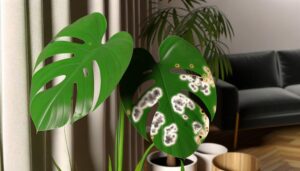Dragon Tail Plant Vs Monstera Deliciosa
The Dragon Tail Plant (Epipremnum pinnatum) and Monstera deliciosa both belong to the Araceae family, yet they exhibit distinct differences. E.
pinnatum, native to Southeast Asia, displays glossy, lanceolate leaves and a vining habit. In contrast, M.
deliciosa, indigenous to Latin American rainforests, features robust climbing structures and characteristic fenestrated, heart-shaped leaves. Both species thrive in bright, indirect light and necessitate well-draining soil enriched with organic matter.
However, M. deliciosa's leaves generally develop larger, more pronounced fenestrations with proper care.
For a deeper understanding of these fascinating botanical specimens, keep exploring.
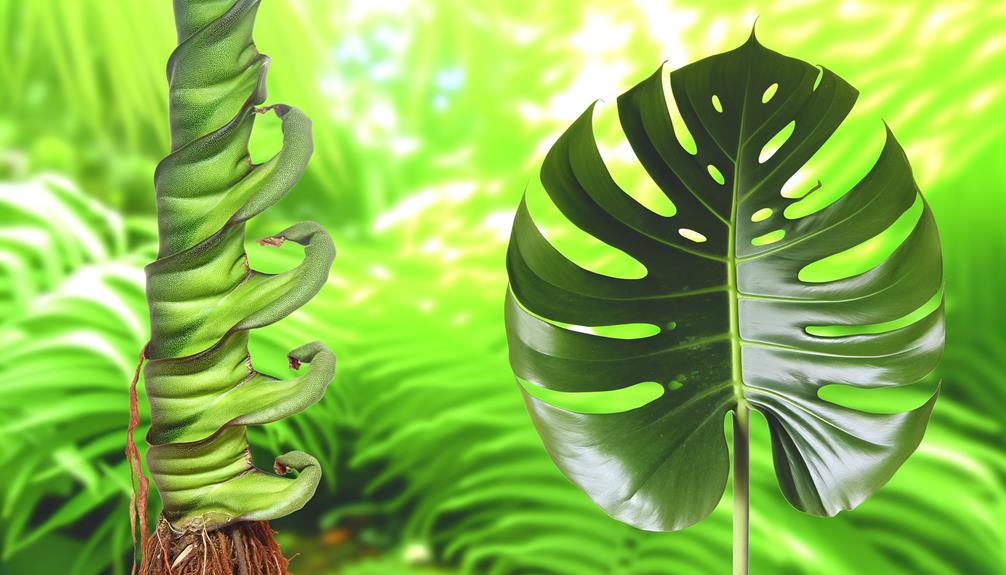
Key Takeaways
- Leaf Characteristics: Dragon Tail Plant has elongated, lanceolate leaves, while Monstera deliciosa has large, fenestrated, heart-shaped leaves.
- Growth Size: Dragon Tail Plant grows up to 10 feet, whereas Monstera deliciosa can exceed 15 feet.
- Light Requirements: Both prefer bright, indirect light but are prone to leaf burn in direct sunlight.
- Stem Structure: Dragon Tail Plant has flexible stems, while Monstera deliciosa has thicker, more robust stems.
- Aesthetic Appeal: Dragon Tail Plant exhibits a vining habit, whereas Monstera deliciosa has an upright, climbing nature.
Origin and Background

The Dragon Tail Plant, scientifically known as Epipremnum pinnatum, and Monstera deliciosa, commonly referred to as the Swiss Cheese Plant, both belong to the Araceae family and originate from tropical regions but differ significantly in their native habitats and historical cultivation practices.
Epipremnum pinnatum hails primarily from Southeast Asia, thriving in the understory of dense tropical forests, particularly in the Philippines and Indonesia. In contrast, Monstera deliciosa is indigenous to the rainforests of southern Mexico and Central America.
Historically, Monstera deliciosa has been cultivated since the late 19th century for its unique fenestrated leaves and ornamental value. Epipremnum pinnatum, however, has gained popularity more recently, appreciated for its adaptability and striking foliage in modern horticulture.
Physical Characteristics
In examining the physical characteristics of Epipremnum pinnatum and Monstera deliciosa, one can observe distinct morphological differences that reflect their unique evolutionary adaptations.
Epipremnum pinnatum, commonly referred to as the Dragon Tail Plant, belongs to the Araceae family and is characterized by its climbing habit and elongated, lanceolate leaves. Its stems are flexible, allowing it to attach and ascend vertical surfaces.
In contrast, Monstera deliciosa, also part of the Araceae family, exhibits a more robust climbing structure, with thicker, sturdier stems that support its large foliage. Both plants produce aerial roots, essential for nutrient absorption and anchoring.
However, Monstera deliciosa's aerial roots are significantly larger, facilitating its growth in tropical rainforests.
Leaf Shape and Texture
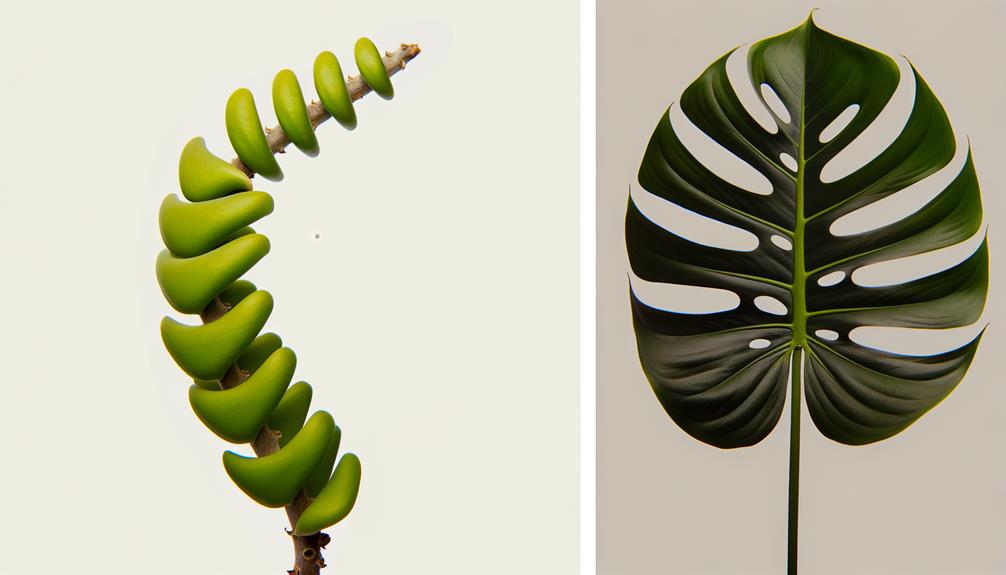
The Dragon Tail Plant (Epipremnum pinnatum) and Monstera Deliciosa exhibit distinct differences in leaf morphology and surface texture.
Epipremnum pinnatum features elongated, lanceolate leaves with a smooth, glossy finish, while Monstera Deliciosa is renowned for its fenestrated, heart-shaped leaves with a leathery texture.
These variations in leaf structure not only reflect their unique aesthetic appeal but also their respective adaptive strategies in their native habitats.
Unique Leaf Patterns
Exhibiting distinctive morphological characteristics, the leaves of the Dragon Tail Plant (Epipremnum pinnatum) contrast sharply with those of Monstera Deliciosa, both in their shape and texture.
The Dragon Tail Plant features elongated, lanceolate leaves that can develop fenestrations as they mature, though often remain entire in juvenile stages. These leaves are glossy and exhibit a deep green hue, with a relatively smooth margin.
Conversely, Monstera Deliciosa is renowned for its large, perforated leaves characterized by deep, irregular lobes and splits, contributing to its iconic aesthetic. The leaf texture of Monstera is robust and leathery, adding a tactile dimension to its visual appeal.
Such morphological disparities underscore the botanical diversity within the Araceae family.
Surface Feel Differences
Although both the Dragon Tail Plant (Epipremnum pinnatum) and Monstera Deliciosa belong to the Araceae family, they present markedly different tactile experiences due to their unique leaf shape and texture.
Epipremnum pinnatum exhibits elongated, lanceolate leaves that are smooth and glabrous, providing a sleek, almost glossy surface feel.
Conversely, Monstera Deliciosa features broad, fenestrated leaves with distinctive perforations and a leathery texture that feels more rigid and robust. These fenestrations not only add visual complexity but also contribute to a more textured touch.
The Monstera's leaves often have a slightly rougher, more substantial feel, contrasting with the delicate, smoother surface of the Dragon Tail Plant. These differences highlight the diverse adaptations within the Araceae family.
Shape Variation Highlights
Both Epipremnum pinnatum and Monstera Deliciosa exhibit distinct morphological characteristics in their leaf shape and texture, reflecting their unique evolutionary adaptations within the Araceae family.
- pinnatum, commonly known as the Dragon Tail Plant, features elongated, lanceolate leaves that may develop fenestrations (holes) as they mature, enhancing light penetration.
In contrast, M. deliciosa is renowned for its deeply lobed, heart-shaped leaves with extensive, natural perforations that optimize photosynthetic efficiency.
Key differentiating features include:
- Epipremnum pinnatum: Narrow, elongated leaves with potential fenestrations.
- Monstera Deliciosa: Broad, heart-shaped leaves with pronounced lobes and perforations.
- Leaf Texture: E. pinnatum has a smoother texture, while M. deliciosa exhibits a more rugged, leathery feel.
These variations underscore their distinct ecological niches and adaptive strategies.
Growth Rate and Size
The growth rate and ultimate size of the Dragon Tail Plant (Epipremnum pinnatum) compared to the Monstera deliciosa are influenced by distinct genetic and environmental factors, with each species exhibiting unique morphological characteristics.
Epipremnum pinnatum, classified under the family Araceae, typically achieves a moderate growth rate, reaching lengths of up to 10 feet in ideal conditions. Its pinnate leaves mature to substantial dimensions, enhancing its aesthetic appeal.
Conversely, Monstera deliciosa, also an Araceae family member, demonstrates a vigorous growth rate, with potential heights exceeding 15 feet. This species is renowned for its fenestrated leaves, which can span several feet in width.
Both taxa require tailored horticultural conditions to achieve their growth potential, underscoring the importance of species-specific care regimens.
Light Requirements
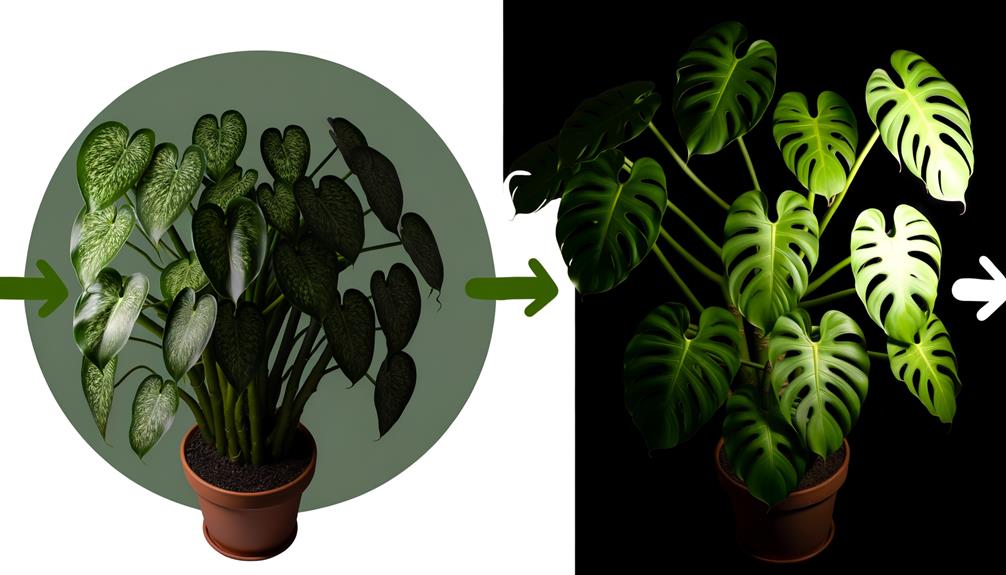
Optimal light conditions for Epipremnum pinnatum and Monstera deliciosa are essential for their physiological health and morphological development. Epipremnum pinnatum, commonly known as the Dragon Tail Plant, thrives in bright, indirect light but can tolerate lower light levels, making it versatile for various indoor environments.
Monstera deliciosa, or the Swiss Cheese Plant, similarly prefers bright, indirect light, which promotes its fenestration—a hallmark of its mature foliage.
- Epipremnum pinnatum: Bright, indirect light encourages vibrant leaf coloration and vigorous growth.
- Monstera deliciosa: Adequate light fosters the development of characteristic perforations and splits in leaves.
- Avoid direct sunlight: Both species are prone to leaf burn when exposed to intense, direct sunlight, requiring careful placement.
Understanding these light requirements ensures the best growth and aesthetic appeal.
Watering Needs
Maintaining ideal hydration for Epipremnum pinnatum and Monstera deliciosa is essential, as their watering needs greatly influence physiological processes such as nutrient uptake and photosynthesis.
Epipremnum pinnatum, commonly known as the Dragon Tail Plant, prefers consistently moist but not waterlogged soil. Overwatering can lead to root rot, a common affliction in this species.
Conversely, Monstera deliciosa, or the Swiss Cheese Plant, requires a more nuanced approach. It thrives with periodic deep watering, allowing the top inch of soil to dry out between watering sessions. This balance prevents both water stress and root rot.
Observing leaf turgor and soil moisture levels can provide critical insights into their hydration status, ensuring the best growth and health for both species.
Soil and Fertilization

Proper soil structure and targeted fertilization play crucial roles in the health and strength of Epipremnum pinnatum and Monstera deliciosa. Both species thrive in well-draining potting mixes enriched with organic matter. Epipremnum pinnatum, commonly known as the Dragon Tail Plant, benefits from a soil blend containing perlite and peat moss. Monstera deliciosa, the Swiss Cheese Plant, prefers a mix of pine bark, coco coir, and charcoal for an ideal balance of aeration and moisture retention.
Key considerations for soil and fertilization include:
- Nutrient balance: Maintain a balanced N-P-K (nitrogen, phosphorus, potassium) ratio for robust growth.
- Organic amendments: Integrate compost or worm castings to enhance soil fertility.
- Fertilization frequency: Administer a diluted liquid fertilizer every 4-6 weeks during the growing season.
Grasping these elements supports plant health and development.
Common Pests and Diseases
Both Epipremnum pinnatum and Monstera deliciosa are susceptible to a range of common pests and diseases, including spider mites (Tetranychidae), scale insects (Coccoidea), and root rot caused by waterlogged conditions.
Spider mites, often found on the undersides of leaves, can cause stippling and leaf discoloration, leading to plant stress. Scale insects, identifiable by their protective waxy coverings, sap essential nutrients, resulting in weakened growth. Root rot, primarily caused by overwatering, is facilitated by pathogenic fungi such as Pythium and Phytophthora species.
Early detection and intervention are crucial; regular inspection, proper watering practices, and the use of horticultural oils or systemic insecticides can effectively manage these issues, ensuring the health and vitality of both plant species.
Aesthetic Appeal
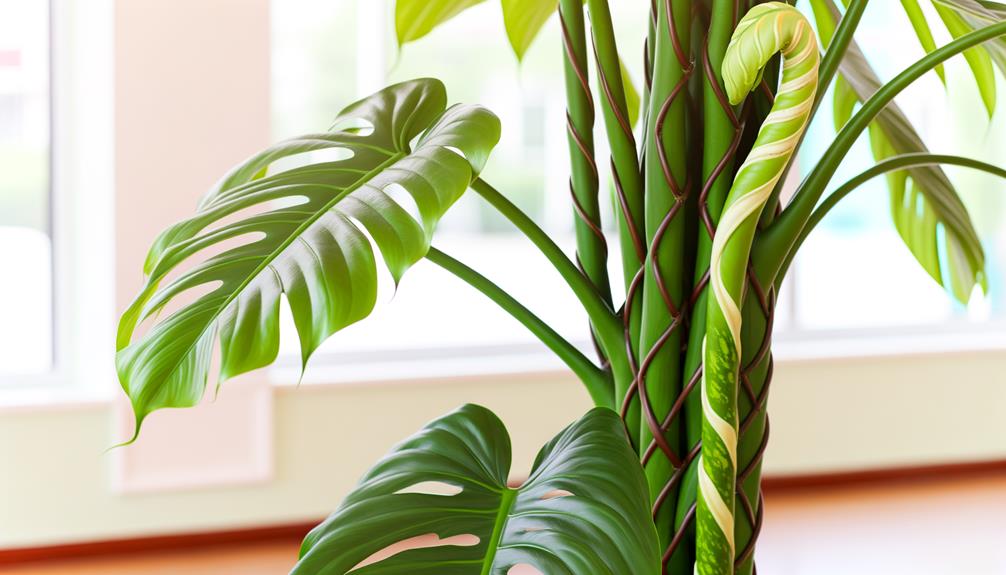
The aesthetic appeal of the Dragon Tail Plant (Epipremnum pinnatum) and Monstera deliciosa is distinguished by notable differences in leaf morphology, pigmentation, and growth habits.
Epipremnum pinnatum features elongated, pinnate leaves with a glossy texture, presenting a stark contrast to the fenestrated, heart-shaped leaves of Monstera deliciosa.
Additionally, the growth patterns of these species vary prominently, with the Dragon Tail Plant exhibiting a more vining habit compared to the Monstera's upright, climbing nature.
Leaf Shape Differences
In examining the leaf shape differences between Epipremnum pinnatum (Dragon Tail Plant) and Monstera deliciosa, the former exhibits elongated, lanceolate leaves with entire margins, while the latter is characterized by its large, fenestrated leaves that develop distinctive perforations and splits as they mature. These morphological traits contribute to their unique aesthetic appeal and ecological adaptations.
- Epipremnum pinnatum: Leaves are slender and tapering, enhancing its climbing habit and maximizing light capture.
- Monstera deliciosa: Fenestrations and splits increase air flow and light penetration, mimicking the dappled sunlight of tropical canopies.
- Taxonomy: Epipremnum pinnatum belongs to the Araceae family, sharing traits with other aroids, while Monstera deliciosa also falls within Araceae, displaying convergent evolutionary features.
Color and Texture
Epipremnum pinnatum features a vivid green hue with a glossy, sleek texture, whereas Monstera deliciosa exhibits a deeper green coloration with a slightly leathery and textured surface, enhancing its visual complexity.
The lustrous leaves of E. pinnatum, commonly known as the Dragon Tail Plant, reflect light effectively, presenting a fresh and clean aesthetic.
In contrast, M. deliciosa, often referred to as the Swiss Cheese Plant, boasts a more subdued yet rich green that adds a layer of depth to its appearance.
The textural dichotomy between the smooth Epipremnum and the leathery Monstera is not merely superficial but also serves as a distinguishing factor in their identification.
These attributes contribute significantly to their ornamental appeal in diverse botanical settings.
Growth Pattern Variations
Characterized by their distinct growth patterns, Epipremnum pinnatum and Monstera deliciosa exhibit unique climbing and sprawling behaviors that contribute to their horticultural and aesthetic appeal.
Epipremnum pinnatum, commonly known as the Dragon Tail Plant, is a vigorous climber utilizing aerial roots to secure itself to supports, creating a dense vertical display.
Conversely, Monstera deliciosa, known as the Swiss Cheese Plant, demonstrates a semi-epiphytic nature, using its aerial roots to both anchor and absorb nutrients while sprawling horizontally.
These growth characteristics are pivotal in their ornamental use, offering varied visual dynamics in indoor and outdoor settings.
- Epipremnum pinnatum: Dense vertical climbing habit
- Monstera deliciosa: Semi-epiphytic with horizontal sprawl
- Aesthetic applications: Vertical gardens vs. broad foliage displays
Conclusion
The Dragon Tail Plant (Epipremnum pinnatum) and Monstera deliciosa, both members of the Araceae family, stand as verdant exemplars in the world of botanical splendor.
With the Dragon Tail's elongated, leathery leaves juxtaposed against Monstera's iconic fenestrated foliage, each plant offers unique aesthetic allure.
Their distinct growth rates, light preferences, and soil requirements underscore the intricate dance of nature and nurture, highlighting the diversity within the plant kingdom while inviting a deeper appreciation of botanical intricacies.


